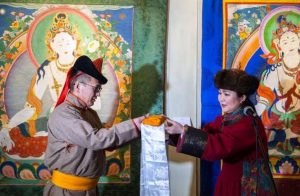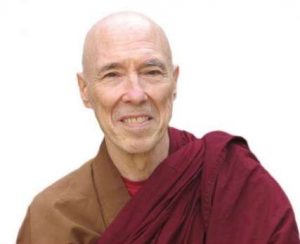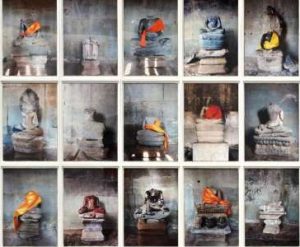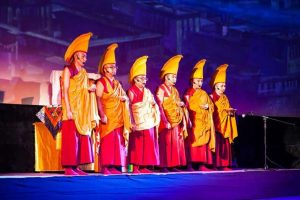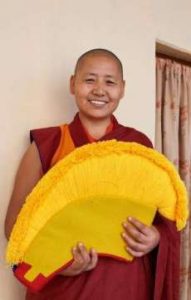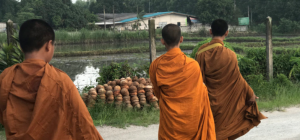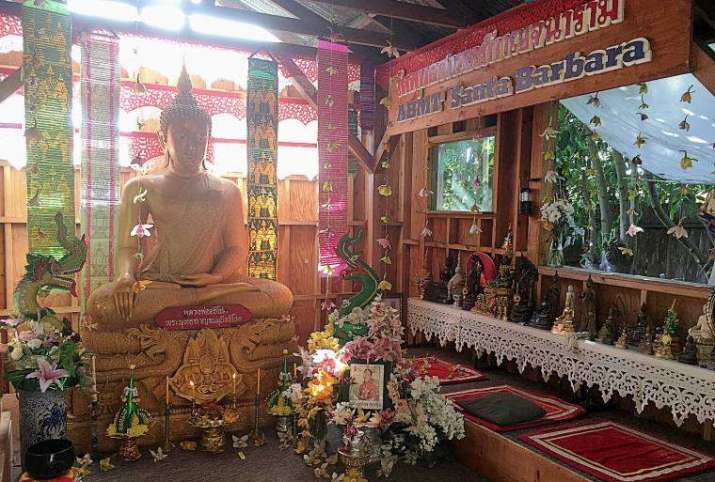
On my return to Santa Barbara after months living near the great stupa at Boudhanath in Nepal, I was curious to see how the Buddhist community there had taken shape. Buddhism is a deeply rooted tradition shared by a large portion of Nepal’s population. After all, the Buddha was born there. This is a stark contrast to the Santa Barbara community on the central coast of California. A very small percentage of Americans practice Buddhism. According to the University of Southern California’s Center for Religion and Civic Culture, only 0.77 per cent of the total population in Santa Barbara attend the six Buddhist temples in the county.
I visited the American Buddhist Meditation Temple (ABMT) in Santa Barbara for a Visakha Puja celebration last year. ABMT is located in a wholesale orchid nursery, a quiet and restorative environment a short walk from the ocean. When I arrived, I immediately felt my entire body and mind relax with ease. I was comfortable entering alone, without knowing anyone there, because I have always felt warmly accepted by the Buddhist community, although I had no idea yet what this community would look like in Santa Barbara.
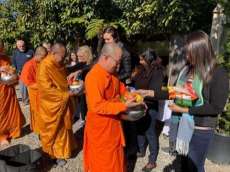
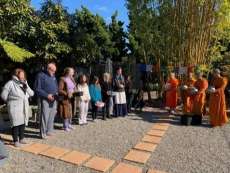
What I found was a diverse, hospitable, kind, and curious mix of people. There were monks from all around the world, immigrants living in Santa Barbara, and White Americans who had no regional connection with the tradition of Buddhism. An amazing discussion occurred near the end of the ceremony between the lay people and monastics from all parts of the world. It was an example of how the Buddhadharma has the power to transcend cultural borders. For me, it was a reminder that the community here in Santa Barbara is one that welcomes, honors, and hopes to learn from those from Nepal, Thailand, and beyond.
I had planned to return to ABMT to interview one of the resident monks for Buddhistdoor Global. But given current circumstances, with the pandemic restricting social movement, I instead spoke via video conference with Ajahn Khamjan, the acting abbot of ABMT, and Courtney Purcell, a dedicated layperson who works with Ajahn to organize programs at the monastery.
I spoke with Ajahn Khamjan on how he came from a village in Thailand to California eight years ago, met Courtney Purcell, and worked with him to make the American Buddhist Meditation Temple a welcoming space for people of all backgrounds. They are a great example of the synergy that is possible when two Buddhist practitioners from different backgrounds align with a similar vision.
I also received insight from both Ajahn and Courtney on how to remain present in the midst of the rampant fear in our world today.
Shaelyn McHugh: Let’s start off by hearing both of your stories. How did you come to where you are now in Santa Barbara?
Ajahn Khamjan: I was 12 when I moved for the first time from my village to the city, about 40 kilometers away. It was such a difficult time. In my first week in the city I ran away back home to the village. After I returned home, my mom asked me: “What do you want? Do you want to live here and work in the rice field, or do you want to go to school and study?”
She sent me back to the city and to another temple, and I spent two years there before moving to Chiang Mai, the largest city in northern Thailand. I lived there for almost 20 years. I studied the Pali language for two years, which I didn’t study in my junior high years, so my first year in high school was difficult. After university in Chiang Mai, I moved to Doi Saket and was an abbot there for three years.
The acting abbot at the ABMT asked me if I would like to come stay in Santa Barbara and I said yes! That was in 2012.
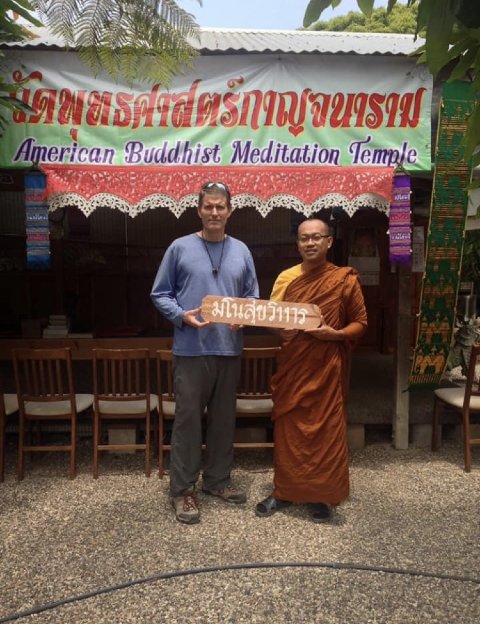
Image courtesy of Courney Purcell
Courtney Purcell: I grew up in a little beach community in southwest Florida, and when I was a young man I happened to read a book that had a dual focus on Zen Buddhism and spending time outdoors, mountaineering specifically. So I embarked on those two paths simultaneously, with the mountain lifestyle emphasized. But in time, my relationship with Buddhism began to grow and blossom. This all started about 20 or so years ago, and I began to identify as a Zen Buddhist and became quite involved with the greater Thich Nhat Hanh community of Vietnamese Zen Buddhism.
In more recent years, when I was summering in Alaska, I had an opportunity to meet some Thai monks during a period of transition in my life. I was ready to make Buddhism a major part of the way that I lived. The timing was right in Alaska with those monks, and my heart was ready to receive Thai Buddhism, which now feels like my family.
I eventually began to live part time in Santa Barbara, and I wanted to seek out a local Thai temple where I could visit, meet others, and practice meditation. I came to the American Buddhist Meditation Temple and met Ajahn, and now I live here full-time and am a rather engaged member of this community at the meditation temple.
SM: Ajahn, what was it like when you first came to California in 2012? Please describe for me your first few years here, leading up to how you found the community here now.
AK: Entering customs, I didn’t understand anything. Although I learned English in school, I struggled a lot speaking it and wanted to avoid it. Everything here is different from Thailand. We have big, beautiful temples in Thailand and here it is a small space in an avocado grove. The one thing that is the same is my window, from which I can look out at the trees. It reminds me of the forest.
The first year here I struggled with my feelings. I was a monk for more than 20 years when I came here. I saw that way reality shows you all the time that, if you miss being aware in the present moment, illusion shows up in your mind and drags it around.
Our temple is here for Thai and Lao Buddhists to run cultural events every year, but in Thailand, we have a main event every month. Those who come to the ABMT are normally immigrants from Thailand, Laos, and Cambodia who missed celebrating events back home. Thai and Laos temples across the US are mainly here to serve the Thai and Lao communities, and so it can be hard to encourage many Westerners to come in.
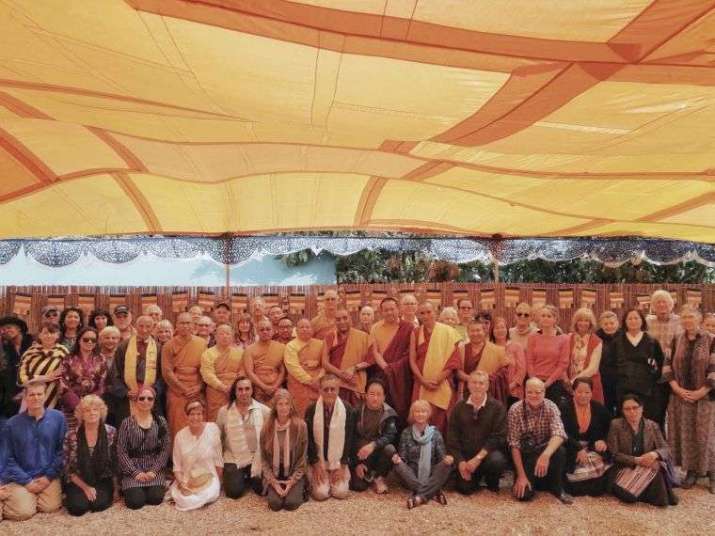
CP: As Ajhan described, he spoke English but was still rather tentative. But after we developed a relationship, he felt more comfortable speaking with me and it allowed him to progress. I wanted to see how I could help make ABMT more welcoming to Westerners who want to practice meditation. And so, over the last few years, we have worked together to develop meditation programs that are oriented toward a Western audience.
Essentially, the Thai and Lao communities support the temple in many ways and have a lot of cultural ceremonies. The Western role has been participating in meditation programs and organizing volunteer days when we invite people to work on different projects around the monastery grounds. The owners of the orchard where it is located are so gracious and generous with not only their property, but also in their love for this community within our community.
SM: When I visited for Buddha Day, I was amazed that the people there felt quite diverse.
CP: What you saw was perhaps a reflection of the effort that Ajahn and I have made to be more inclusive. When you’re a Westerner, born and raised in a country that’s by no means predominantly Buddhist, if you enter the cultural environment of a Thai temple, you can very easily feel like a fish out of water. You don’t understand what’s going on—from the language and the decor, to the rituals. It is rewarding to hear you had a nice experience because that has been our goal.
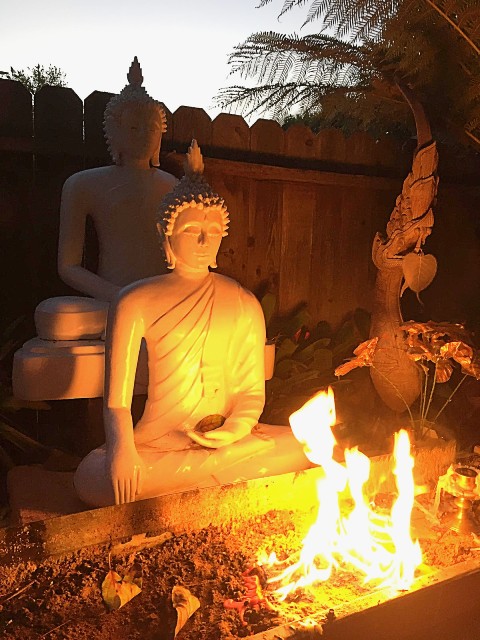
Image courtesy of Ajahn Khamjan
SM: I am glad to see how you are being creative in supporting your members during COVID-19 by performing live online offerings, including chanting programs, with the monks everyday on Facebook, and with meditation-oriented programs. I’d like to hear your advice for people, such as students, who are in a period of transition during this time and are seeing few opportunities for the future. How can we stay present and remain hopeful?
AK: The most powerful advice I gave my younger brother when he graduated was to do whatever you can. Sometimes it’s not only about earning, it’s about spending your time gaining experience after you graduate. If you are busy with something, it will help you be in the present moment and help you calm your mind. We have to speak, we have to think, and we have to act with kindness. Earn a little bit, or earn a lot, and seek the opportunities that come from the right place at the right time.
We can use this time of isolation well to start a meditation practice, and if you already have one, you have more time to practice. This is a time to acknowledge what you are feeling as just a mental phenomenon. Let these feelings serve you as a teacher and know that they will pass.
The Buddha gave us a map, but you need to walk the path by yourself. Sometimes it’s easy and sometimes it’s difficult. Enlightened moments come and go just as quickly as the gloomy ones.
CP: I feel like we often seek advice from people that we respect and we know, such as our parents or our grandparents. When I was at a point of transition in my life, I spoke with my grandparents, who I knew had been free-spirited types. I asked them what I should do, and they told me that if you don’t take advantage of opportunities, and if you don’t follow your dreams, chances are that you may come to regret it one day. But if you follow your dreams and take a chance, you’re not going to regret it. And that is what I did, I’ve never regretted it; this lifestyle has served me very well and has felt so rich.
As you begin to cultivate mindfulness and awareness of the experiences you are having right now, you notice how all of your thoughts and feelings are constantly changing. Maybe you wake up one day, read the news, and are in a gloomy mood, but you notice that it doesn’t last. You realize that even if you thought you were in a bad mood, you had random thoughts interspersed about cooking, something funny, or a conversation you once had.
Like Ajahn said: you first must recognize what you are feeling and reflect on the fact that you didn’t ask for it to be there. When you pay attention to these things that happen on their own, it’s easier to learn to let them go.
See more


